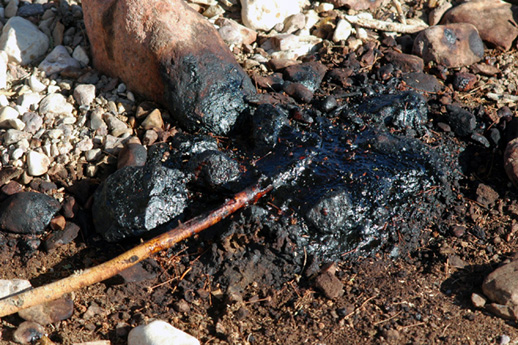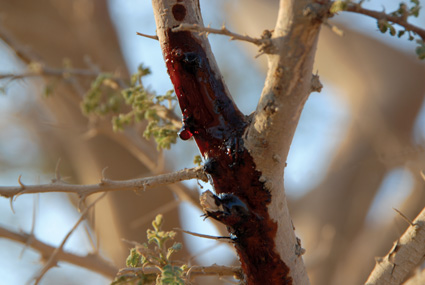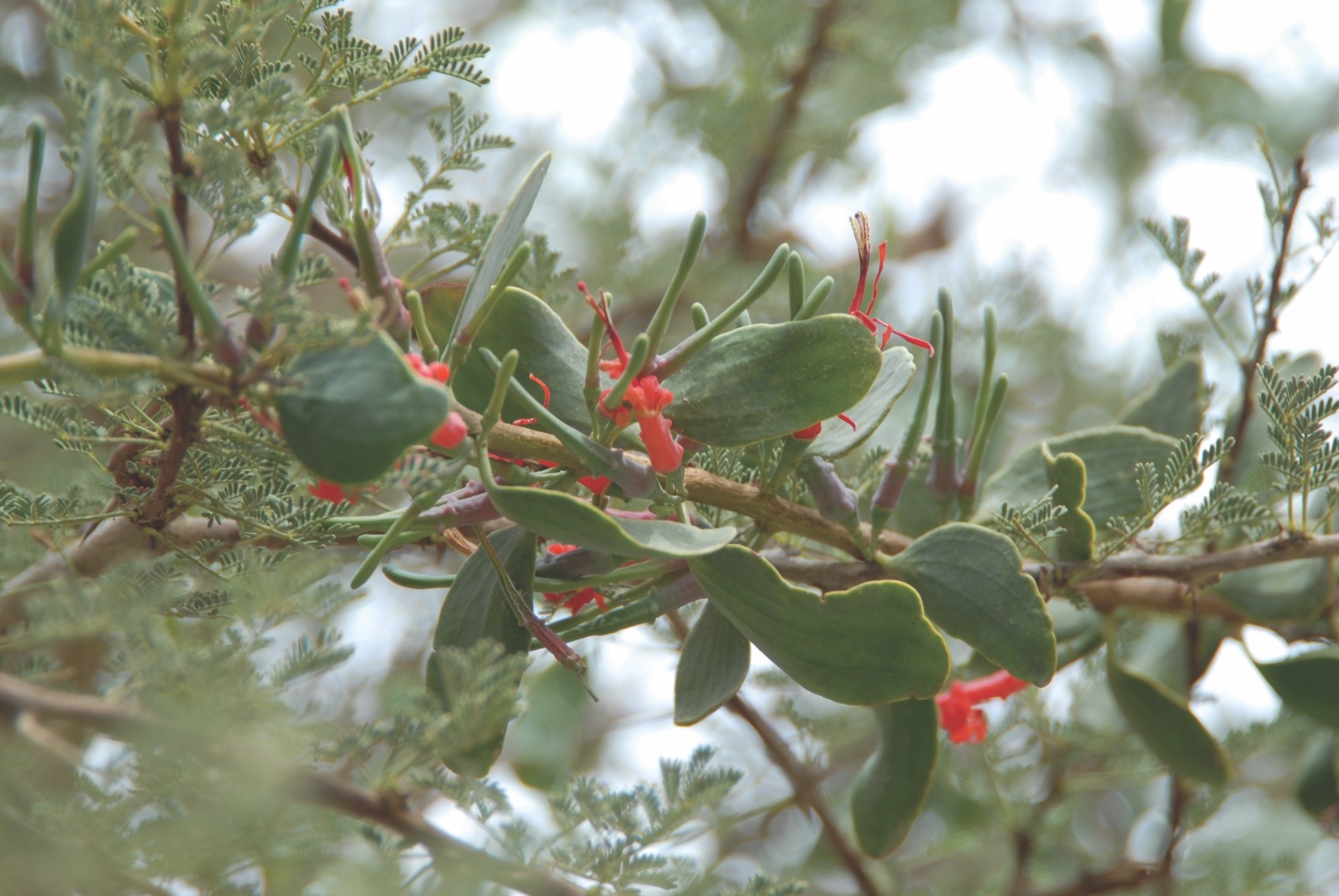The Acacia Tree, The Sacred Vine & The Midianites
There are three Acacia tree species in this region: The “Acacia tortilis subsp. raddiana” (Bedouin: Sayyal), Umbrella Thorn Acacia “Acacia tortilis subsp. tortilis” (Bedouin : Samar, Samarah) and giant Talh. Many parts of the tree including roots, shoots, and pods are also often used by natives for a vast number of purposes including tools, and medicines. It is believed that exposure to the Acacia smoke relieves rheumatic pains.
The Acacia was considered sacred in the Old Testament, and it was forbidden to use its wood for any secular purpose, such as building homes or making furniture.
The Acacia tree was also sacred to the Arabs, who used its wood to make idols ...of their deity Al Uzza. The ancient traditions of Arabia suggest that the goddess Al Uzza resided in the Acacia tree (Shajarat Samarat). According to The Book of Idols by Hisham al-Kalbi, an arab built a house called “Buss” over Al Uzza groves, in which people used to receive communications from the oracle.
Another shepherds deity also believed to reside in a tree was Egyptian Hathor. Interestingly, Hathor was worshiped by the Midianites, who where also associated with the Acacia tree "Ayka" near the gulf of Aqaba on the Red Sea.
One of the titles of Osiris was 'He that Dwelleth in the Acacia Tree'.
It is believed that the chemical substance DMT found in many Acacia species can produce a powerful psychoactive effect, causing revelatory mind states with profound spiritual and intellectual ramifications.
In the Arabian and Islamic tradition, the Midianites name were associated with the semi-parasitic plant that grows on top of the Acacia tree. This plant is known as Ayka or Aika (Arabic.) The Aika grows in a vine that resemble a coiled snake. When in full bloom, the vines produce red flowers that, when seem from a distance, create the illusion that the tree is on fire. Thus, according to some Hebrew sources, the Loranthus acaciae vine is called the burning bush.
Could it be the the tribes looked at the semi-parasitic plant that grows on top of the Acacia tree as a symbole of the holy spirit or the higher consciousness that descends from the heavens only to the big, wise and mature. (the semi-parasitic plant only grows on top of the giant big Acacia trees)??
However, the association between the Aika and the Midianites is rarely touched upon by the scholars.
The Midianites & The Sacred Vine
In the history of region, there was a tribe directly associated with a historically entheogenic plant. This tribe was known by the name of Midian.
Midian is the geographical location on the Red Sea and Sinai. It is the place where Moses spent his voluntary exile after killing the Egyptian. While there, Moses married the daughter of a shepherd and holy man a "Shaman" a "Plant Herbalist" named Jethro "Shu'ayb,". The Islamic tradition speaks extensively about the people the Midianites who have special relation with a tree "Ayka", who went astray at the end of their era.
According to the Biblical account, the Midianites were nomadic shepherds who traveled across the desert in small bands with their goats and camels. They lived in tents made of goat hair, and their diet was primarily composed of dairy products, and bread baked in hot charcoal and sand. The Midianites were rich in camels, incense and gold. They were the craftsmen largely responsible for constructing the Ark of the Covenant using Acacia wood (Hebrew: Shittim) in the Wilderness for Moses.
To the Shaman the Acacia tree with its semi parasitic vine symbolizes the path of the fire spirit that rises from the base of the spine to the apex of the skull (similar to the concept of Kundalini). Alchemists in the Middle Ages, who derived their science primarily from the Arabs, spoke about the "Fire" necessary in all alchemical operations, and they also spoke about a “Living Silver”: a spiritual water, symbolized as a serpent of quicksilver.
According to Manly P Hall in his book, The Secret Teachings of All Ages: “Certain plants, minerals, and animals have been sacred among all the nations of the earth because of their peculiar sensitiveness to the astral fire - a mysterious agency in Nature which the scientific world has contacted through its manifestations of electricity and magnetism. Lodestone and radium in the mineral world and various parasitic growths in the plant kingdom are strangely susceptible to this cosmic electric fire, or universal life force.”






In order to better understand the Midianites' use of the Ayka vine and its hostess the Acacia tree, we turn to a similar practice that has been well documented and researched in the forests of South America.
Today, many spiritual seekers travel to Peru to work with Ayahuasqueros, shamans who engage in the ritual use of ayahuasca. The psychedelic ayahuasca tea is used to cure everything from depression to addiction. When taking ayahuasca, participants frequently report meeting spirits and receiving divine revelations.
Ayahuasca is a name of various psychoactive infusions or decoctions. It is prepared from the Serpent-like plant called the “Banisteriopsis spp. vine,” mixed with the leaves of dimethyltryptamine-containing species of shrubs from the Psychotria genus. The brew was first described academically in the early 1950s by Harvard ethnobotanist Richard Evans Schultes, as being used by the Amerindians of Amazonian Colombia for divinatory and healing purposes,
Ayahuasca is also largely used as a religious sacrament among indigenous peoples like the Urarina of Peruvian Amazonia and several other tribes in south America. It is used in the religion of Santo Daime: a syncretic spiritual practice founded in the 1930s in the Brazilian Amazonian state of Acre.
In south America sections of B. caapi vine are cut and boiled alone or with leaves from any of a number of other plants, including Psychotria viridis (chacruna) or Diplopterys cabrerana (also known as chaliponga). The resulting brew contains the powerful hallucinogenic alkaloid N,N-dimethyltryptamine (DMT), and MAO inhibiting harmala alkaloids, which are necessary to make the DMT orally active. This is a sophisticated concoction, whereas the removal of only one of the ingredients would metabolize the substance in the digestive tract and thus would have no effect on the brain.
It should be noted that brews can also be made with number of DMT containing plants. Psychotria viridis could be substituted by plants such as Justicia pectoralis, Brugmansia, or sacred tobacco (also known as Mapacho, or Nicotiana rustica.) The potency of the Ayahuasca brew varies radically from one batch to the next, both in potency and psychoactive effect, according to the skill of the herbalist.
In North-East Arabia and at Midian, the ayahuasca analogue seems to have been prepared with the harmla seed and the Acacia tree. The Harmala serves as a substitute for the ayahuasca vine, while the DMT-rich Acacia replaces the Amazon chakruna plant.